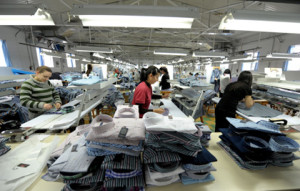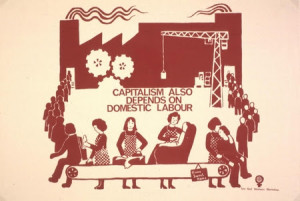After the Second World War, the textile industry in Macedonia greatly expanded, eventually reaching a point where it represented over 30% of the country’s total manufacturing. The largest portion of this industry was situated within Shtip, a small city located in Eastern Macedonia. Today, the city has a population of less than 50,000 people, the majority of whom are now retired. During the 1980s, approximately 6,000 people – a massive number in comparison to the Macedonia’s population – were employed by the biggest textile factory in the country: Makedonka (Македонка). During this period, Macedonia was still part of Socialist Yugoslavia; however, after the break-up of Yugoslavia and the privatization of most of the companies, the textile industry underwent extreme changes, which subsequently changed the circumstances of the people working in it (CRPM 2006, Gjurovska 2008). Combined with the denationalization and privatization of Macedonia’s textile companies, and the influx of foreign investments in the country’s textile industry, the transformation had a violent effect on the lives of Macedonian women, who in 2004 (and likely still to this day) constituted 96% of the textile factory work force (CRPM, 2006).
The discovery of a cheap female labor force in Macedonia, though not considered a “third world country”, produced the same narrative of gender violence resulting from the rediscovering of the ‘third world women’ by international capital that Maria Mies describes in relation to factories in India and China. I expand on her concept of the new international division of labor (IDL) — that is, the consumer/producer division — to explore how the links between “consumer-housewife” and the “producer-housewife” (Mies, 1986: 127) are played out in the case of Macedonia. In her book Patriarchy and Accumulation on a World Scale Mies presents four possible linkages between consumer-housewives and producer-housewives in relation to the sexual division of labour with the new international division of labour. These four linkages are: (a) Women in agriculture and dairying, (b) women in handcraft production, (c) women in the electronics industry, and (d) women in prostitution/tourism. For the purpose of my paper I am taking her example of linkage “c” to create a sub-linkage which will reflect the situation in the Macedonian context (Mies, 1986: 127). As Mies writes “one could add a number of examples” to show the relationships and structures that work between this new international division of labor (ibid.), which is what I will try to do considering the case of the city of Shtip.
Together with the changes in the city’s textile industry and the increasing trend of clothes manufacturing for international consumption, Shtip saw a notable rise in reported cases of domestic violence. In order to show the relationship between gender violence and the internationalization of industry and in addition to Mies, I also draw on the work of Tithi Bhattacharya[1] and Ciniza Arruzza. I believe Arruzza’s ‘unitary thesis’[2] of understanding capitalism as a “complex and articulated social order (…) that (…) consists of relations of exploitation, domination, and alienation” (Arruzza, 2014) – best illustrates the frustrations and violence which result from the interplay between patriarchy and capitalism.

My knowledge of the realities in the city of Shtip is grounded in news reports, research policy papers, scholarly findings, and common experience as a Macedonian woman. For a more helpful analysis and comparison to the examples in Mies’ and Bhattacharya’s articles, I will also use scenes from a documentary movie, titled “The Seamstresses” (dir. Biljana Garvanlieva short video here). The documentary focuses on the lives of three women working in one of the textile factories in Shtip. It presents the viewpoints of their families, husbands, the opinions of other inhabitants of the city, and one manager of one of these factories. It reflects a sad, cruel story of a city where most of the women serve as the ‘breadwinners’ in their families, while being simultaneously exploited at work and home. The women in “The Seamstresses” are employed in jobs that are considered both necessary and undervalued, and their hopes are smashed by the hand of capitalism. This tale is not only a reflection about Macedonian society, but also of all the other communities that are similarly exploited by and through international neoliberal practices.
The Macedonian Context and the Case of the City of Shtip
Macedonia consists of mainly mountainous terrain. The main production in this geographic location used to be primarily farming and some agriculture (Gjurovska, 2008). After the Second World War, Macedonia emerged as part of then Yugoslavia, which reoriented the country’s manufacturing from farming to industry. This process happened as a result of the socialist tendencies oward increasing the industrial power in countries[3]. Mileva Gjurovska writes that this in turn resulted in the massive employment of unqualified work forces in factories (2008). The textile industry was no exception. This textiles flourished in the city of Shtip, where this industry became largely concentrated. With the opening of the biggest textile factories in the region — Makedonka and Astibo — more than half of the city’s work force was soon employed in them (CRPM, 2006). From their inception, the majority of both Makedonka and Astibo’s employees were women, and according to Chiara Bonfiglioli’s ethnographic research, working conditions were markedly better than now (2014). Some decades later however, circumstances, including the fall of Yugoslavia, the wars that followed, the independence of Macedonia, the post-socialist transition to capitalism, and the Greek veto from 1994, significantly weakened the economy in that particular region and throughout the country as a whole (CRPM, 2006). These changes greatly influenced the textile industry in Shtip. By the time the 1990s arrived, the privatization of these two textile factories had begun. By the onset of the new millennium, Makedonka and Astibo’s liquidation led to the division and purchase of the factories by new owners. These were directly connected to international, Western companies that operated by completing orders from other countries. The cheaper labor force offered within Macedonia cut production costs for the newly formed factories (ibid.). In the midst of the economic crisis going on in this period, Macedonian companies could not afford to produce goods solely for national consumption as direly impoverished, Macedonian individuals and families could not afford purchasing the products. These circumstances were strategically used by the international companies that took over Makedonka and Astibo. Choosing these factories for their cheap labor force they effectively made what Mies calls “the international labor division” gap even bigger (1986: 112). As a developing country, Macedonia became an area of production only. The products that the factories in Shtip produced were no longer designated for the real needs of the Macedonian inhabitants but rather for the needs of developed countries. Germany became the main consumer of Makedonka and Astibo’s products. What is more, such a shift was effective in preventing “outbursts of social unrest” in the developed countries, as goods that were previously considered a luxury are now available for mass consumption. The fact that they are produced by workers in countries with low wage levels remains a public secret. Women in both the developing and the developed countries play an essential role in this process (Mies, 1986: 114).

In the present period, there are 58 textile factories in Shtip that produce clothes mainly for export to western European countries. The majority of the workers in these factories are women, making up 96% of textile workers in Shtip (CRPM, 2006). This can be explained by Mies’s concept of the ‘housewifization’ of women’s labor (1986: 119): “contrary to what is commonly accepted, women, not men are the optimal labor force for the capitalist (…) accumulation process…” (1986: 116). This “housewifization” is due to the fact that the place for women is perceived as the home, and not as workers in a factory. This contributes to the perception of their work in the public marketplace as auxiliary, and thus unworthy of equal pay. In the case of Macedonia and specifically Shtip, the level of education plays a big part in the wage level as well. Namely, most of the women in this city have elementary, or at most high school, educations (Gjurovska 2008).
Pointing to this lack of education as diminishing qualifications for work is another way to lower the value of women’s labor. The average salaries that women workers in the factories earn are around 150 euros (Gjurovska 2008). Yet in many cases 150 euros is in fact the average earning only officially. In reality, however, salaries for women are much lower (Bonfiglioli, 2014). What is more, they are often coupled with arduous overtime hours and extreme conditions. The latest news report on these circumstances happened earlier this year (2015), when during the summer a female worker died of a heart attack in one of the factories in Shtip. The media reported that her death was due to the unbearably high temperatures in the factory[4]. Such temperatures are not anomalous as Macedonian summers are extremely hot and air-cooling systems are rare in most work places, aside from offices in the capital. Despite the unbearable conditions, women working in the factories cannot complain for fear of getting fired. Mies’ observation from India and China that “trade unions have never taken an interest in women” (1986: 116) is also confirmed in Shtip. Thus, women workers in Shtip are double disadvantaged. First, they are denied their identity as workers and primarily defined as housewives since they are expected to do the housework in the first place. This might sound paradoxical when taking into consideration the post-socialist context, in which one would expect to find hang-overs from the ‘gender equality’ promoted in the time of socialism. However, as Slavenka Drakulic points out in her article How Women Survived Post-Communism (and Didn’t Laugh), this ‘promoted gender equality’ was the case only in the public sphere (2015). Privately, women still carried the biggest burdens of the household. Second, they are isolated from and unaware of the potential of organizing into unions in order to be able to ask for better work conditions. According to the Clear Clothes Campaign report on the textile industry conditions in Macedonia, workers understand trade unions to belong more to the old socialist system (2012). Nowadays, trust among the workers in the trade unions is lost as workers don’t believe trade unions really care about their interests (ibid). This is highly appropriate and desirable for the managers of the factories and those who make the orders.
Conversely, if women in Shtip were aware of the potential for organizing in order to make demands and improve conditions, their existential fears might outweigh the possibilities. As evidenced in the documentary “The Seamstresses”, women in Shtip are the breadwinners in their homes. Again, the Clear Clothes Campaign report states: “Women in particular avoid anything that could jeopardize their job because their families depend on their income to survive” (2012: 12). The city is a unique phenomenon; according to Gjurovska, the feminization of this occupation prevents men from working in these factories. She claims that if you give enough money to a man, he would also be satisfied and agree to use the sewing machine (2008: 30). Accepting this argument, I would go further with Mies’ claim that not only abysmal pay and difficult working conditions keep men from entering the workforce of these factories; capitalism simultaneously requires that the division of traditional gender roles and the “classical capitalist couple” of the universal model of a housewife and breadwinner is maintained (1986: 119). Even if the factual situation is not like this, the model still needs to be defended and represented so that women’s labor is devalued and used for the sake of capital production. In this way, women bear a double burden of structural and direct violence and coercion by which they are “exploited and superexploited” (Mies 1986: 145). Working outside of the home amidst horrifying conditions and for much less than the average salaries in the country, upon returning home they are also obliged to work for free as housewives.
But what is the other side to this story? In order to see the structural connection and relationships that exist in the new international division of labor, one must compare the situation of the producer to the one of the consumer. In the west, clothing has become incredibly, and ever-increasingly, affordable. Fashion changes every season. Clothes that are bought are disposable, and not meant to last for more than a year. This brings big capital flows from the consumers. A 2014 report by the American Apparel and Footwear Association estimates that “apparel and footwear contributed a record $361 billion to the U.S. economy in 2013, a bigger contribution than new cars, alcohol, toys, or practically any other industry”. Further, “on average, every American, including every man, woman, and child in the United States, spent $1,141 to purchase 64 garments and 7 ½ pairs of shoes in 2013, more than any other country in the world” (AAfA, online). Considering the fashion industry, including magazines and shows, the main target group for fashion-consumption is evidently women. Creating the image of women as consumers, the image of the consumer-housewife is further cemented. As women in the west progressively move out of work in textile factories[5], they are increasingly promoted as only consumers of these factories’ products. This cyclically stabilizes gender roles and stereotypes even more. Western women are seen as consumers who spend their husbands’ money on shopping, and in this way, the typical housewife role is played: she spends the money that he, the breadwinner, brings home. At times the ability to consume all that one wants is even promoted as some form of feminist liberation[6]. Once again, neoliberal capitalism refigures the ‘classical capitalist couple’, regardless the side of the globe in which it appears. This is how it is possible to maintain the new international division of labor.
Gender Violence in Shtip
The case of the Shtip workers also proves, sadly, that there is a direct relationship between structural and physical violence. Reports on cases of domestic violence in the city of Shtip confirm increased violence that directly overlaps with the phenomenon of women being breadwinners and housewives at the same time. News sources are reporting alarming numbers of domestic violence almost exclusively toward women[7]. The few cases of reported violence against men were claims of psychological torture by women against their husbands. This torture was sometimes reported if the woman did not manage to bring food to the table, which further emphasizes the paradoxical patriarchal and capitalist expectations: although women in Shtip are the only workers in the family, they are still expected to do every single job at home as well. This is the paradox Bhattacharya points to: capitalism needs women both as workers and as housewives who reproduce new workers. This paradox produces direct violence toward women. In cases where women, rather than men are the breadwinners, “men still believe or are expected to fulfill the breadwinner’s role” (2013, online). When men perceive that they have lost their control, which is granted and reinforced by patriarchy, they are more prone to committing violence. The case of increased domestic violence in Shtip (pointed in the media) can be explained by this logic. At one point in “The Seamstresses”, one man states that “women work and men go to kafeani[8]”. These dynamics are also evident in a later scene concerning a family in which the woman works all day long and her husband gambles on the football. It appears that the patriarchal expectations of gender roles are harmful if they cannot be met. What I want to further argue is that, in this case, gender violence is not only directed against women but also against men. Conceptions of masculinity that require men to be breadwinners and the heads of households are toxic and harmful to both women and men. In a context where men are largely unemployed due to mass privatization, they are all but eagerly or voluntarily sitting at home drinking and gambling. The capitalist system reproduces itself through hidden narratives of tradition, which produce such roles, thus remaining firmly in place so that it can use the maximum of the cheap labor force and gain the biggest capital possible. This in turn brings frustrations and violence. It is a complex circle of causal relations in which the workers suffer the most.
Final Remarks

What we can evidently see in the situation in Shtip is not a unique phenomenon; however, it clearly connects the new neoliberal division of labor and the increase of violence against women. In Macedonia, Shtip is considered a discrete phenomenon and sometimes even a shame, as it is the city where only women work. Yet this shame does not come from the awareness that women are exploited but rather that the ‘real’ breadwinners (i.e., men) are not performing their ‘proper’ i.e. socially acceptable roles and duty. People are aware that the situation is difficult, but rarely does anyone blame the neoliberal practices that produced it; rather, even the exit from the crisis is seen through these practices. For example, the Macedonian government in 2005 joined the World Trade Organization and signed the Stabilization and Association Agreement with the European Union, which brought a new law on taxing import and export goods. With this law, taxes on the import of goods that need to be manufactured in Macedonian factories (including textile) were repealed (CRPM, 2006). Thus, raw material can enter even easier in the country and so will better facilitate workers’ exploitation. The next step was approaching the European System of Diagonal Cumulation. This would lower taxes for the export of the final products from Macedonia to Europe (that were 12% of the product) and increase the competition on the market. Although this did not happen until this year, the question of when it happened, here, is not even so relevant. What is more relevant is that none of these new concessions took into consideration the social issues resulting from this new communication between the developed countries and Macedonia. It was celebrated as a great achievement of the Macedonian economy because now the prices of the products made in Macedonia can be even cheaper. Nobody discussed the possibility of increasing the wages of the workers or making the working conditions better. And how could they, since these debates risk Macedonia’s exclusion from the highly competitive international market. In this manner, the state continued being the main mediator between the neoliberal usurpers and the cruelly exploited (women) workers. Once again the “hierarchical and oppressive relations” that are reproduced by the international dynamics of capital accumulation can be detected (Arruzza, 2014). Because of this, women in Macedonia, and not only there, continue to experience these brutal mechanisms on an economic level as well as on any other social level of the capitalist whirlpool.

Neda Petkovska is a MA student in the Erasmus Mundus Programme – GEMMA ( in women’s and gender studies).
She is currently working on her masters thesis at the Central European University in Budapest.
Her research interest focuses on gender, social reproduction theory and nationalism in media discourse.”
References:
Arruzza, Ciniza. “Remarks on Gender” in Viewpoint Magazine, 2014. (Web) <https://viewpointmag.com/2014/09/02/remarks-on-gender/> Last Visited on 23.12.2015
ApparelStats 2014 and ShoeStats 2014, Reports. AAfa (American Apparel and Footwear Association), January, 2015. (online) <https://www.wewear.org/apparelstats-2014-and-shoestats-2014-reports/>
Bhattacharya, Tithi. “Explaining Gender Violence in the Neoliberal Era” in International Socialist Review, 2013. (web) <http://isreview.org/issue/91/explaining-gender-violence-neoliberal-era> Last visited on 23.12.2015
Bonfiglioli, Chiara. “Gender, Labour and Precarity in the South East European Periphery: the Case of Textile Workers in Stip” in Contemporary Southeastern Europe, (2), 2014. Pp.7-23.
Clean Clothes Campaign, Net-Work-Wear, Setem. Made in Europe: Swiss, Austrian and German Workwear Suppliers Profit from Macedonian Workers’ Poverty and Fear. 2012.
Davis, Y. Angela. Are Prisons Obsolete? New York, Seven Stories Press, 2003.
Drakulic, Slavenka. “How Women Survived Post-communism (and Didn’t Laugh)” in Eurozine, Summer, 2015. http://www.eurozine.com/articles/2015-06-05-drakulic-en.html
Gjurovska, Mileva. Sociology of Women’s Labor [Социологија на Женскиот Труд]. Skopje, Univeristy of Ss. Cyril and Methodius, 2008.
Macedonian Clothes for Europe. Skopje: Center for Research and Policy Making, 2006. Online link for downloading: <http://www.crpm.org.mk/wp-content/uploads/2012/03/MACEDONIAN-CLOTHES-FOR-EUROPE1.pdf>
Mies, Maria. Patriarchy and Accumulation on a World Scale: Women in the International Division of Labor. London, Zed Books, 1986.
Power, Nina. One-Dimensional Woman. O Books, 2009.
Online news reports:
“Alarming Numbers of Domestic Violence in Shtip [Алармaнтни бројки на домашно насилство во Штип]” on 24 News [24 Вести]. Published on: 20.07.2013. Last Visited on: 23.12.2015
<http://www.24vesti.mk/alarmantni-brojki-na-semejno-nasilstvo-vo-shtip>
“Tragedy: A Worker Died in a Textile Factory in Shtip [Трагедија: Почина работничка во текстилна фабрика во Штип]” Published on: 08.07.2015 Last visited on. 23.12.2015
<http://www.libertas.mk/%D1%82%D1%80%D0%B0%D0%B3%D0%B5%D0%B4%D0%B8%D1%98%D0%B0-%D0%BF%D0%BE%D1%87%D0%B8%D0%BD%D0%B0-%D1%80%D0%B0%D0%B1%D0%BE%D1%82%D0%BD%D0%B8%D1%87%D0%BA%D0%B0-%D0%B2%D0%BE-%D1%82%D0%B5%D0%BA%D1%81%D1%82/>
“The Seamstresses”. Documentary film by Biljana Garvanlieva, 2010. Short Version available on <https://vimeo.com/54517757>
[1] http://isreview.org/issue/91/explaining-gender-violence-neoliberal-era link to the article.
[2] https://viewpointmag.com/2014/09/02/remarks-on-gender/ link to the article
[3] In 1954 the two major industries in the country were the tobacco industry and the textile industry. Women were employed mainly in the textile industry with 66,8% of the total number of the female work force, and 52,5% in the tobacco industry (Gjurovska, 2008: 201).
[4] http://www.libertas.mk/%D1%82%D1%80%D0%B0%D0%B3%D0%B5%D0%B4%D0%B8%D1%98%D0%B0-%D0%BF%D0%BE%D1%87%D0%B8%D0%BD%D0%B0-%D1%80%D0%B0%D0%B1%D0%BE%D1%82%D0%BD%D0%B8%D1%87%D0%BA%D0%B0-%D0%B2%D0%BE-%D1%82%D0%B5%D0%BA%D1%81%D1%82/ – link to the news report.
[5] This claim however is generalized. For example, if we take Angela Davis’ notion on prison as industrial complex and the latest trends of prison outsourcing, it might be that inmate women actually do work in the textile industry.
[6] An idea that is widely criticized by Nina Power in her book One Dimensional Woman.
[7] http://www.24vesti.mk/alarmantni-brojki-na-semejno-nasilstvo-vo-shtip – link to the news report.
[8] Sort of like Macedonian pubs.

